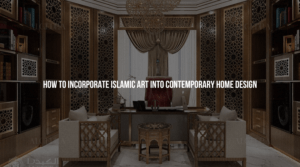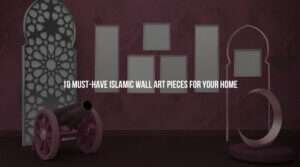In today’s cultural society, embracing diversity is essential, including in the world of home decor. For Muslims, decorating their homes is not just about aesthetics but also about reflecting their faith and culture. Islamic home decor shows a rich history of design elements that carry deep symbolism and spiritual significance. Whether you’re a practicing Muslim or simply appreciate the beauty of Islamic art and design, here are eight essential things you must know about Muslim home decor.
Understanding Islamic Design Principles
Islamic design is characterized by its adherence to certain principles rooted in Islamic teachings. These include the prohibition of representing living beings in art, the emphasis on geometric patterns, and the widespread use of calligraphy. Understanding these principles is fundamental to creating authentic Islamic decor.
Importance of Calligraphy in Muslim Home Decor
Calligraphy holds a central place in Islamic art and design, representing the divine word of Allah. Quranic verses, Hadiths (sayings of Prophet Muhammad), and other religious texts are often rendered in intricate calligraphic styles and displayed prominently in Muslim homes. Calligraphy adds elegance and spirituality to the decor.
Symbolism in Geometric Patterns
Geometric patterns are another hallmark of Islamic art, symbolizing the infinite nature of Allah and the interconnectedness of all creation. These intricate patterns adorn everything from carpets and textiles to tiles and architectural elements in Muslim homes, evoking a sense of harmony and unity.
Embracing Natural Elements in Islamic Decor
In Islamic tradition, nature is revered as a manifestation of Allah’s creation. As such, incorporating natural elements like wood, stone, and plants into home decor is encouraged. Wooden furniture, stone accents, and indoor greenery not only add beauty to the space but also evoke a sense of tranquility and connection to the natural world.
Importance of Lighting for Ambiance
Lighting plays a crucial role in setting the ambience of a Muslim home. Soft, diffused lighting creates a warm and inviting atmosphere, ideal for relaxation and contemplation. Lanterns, pendant lights, and candles are popular choices for illuminating Muslim interiors, adding a touch of warmth and intimacy to the space.
Creating Serene Prayer Spaces at Home
For practising Muslims, having a designated prayer space at home is essential. This sacred corner is adorned with Islamic art, prayer mats, and other religious artifacts, providing a serene environment for daily prayers and spiritual reflection. Designing a prayer space that fosters tranquillity and concentration is key.
Incorporating Islamic Art and Textiles
Islamic art has a wide range of mediums, including paintings, ceramics, and textiles. Incorporating these art forms into home decor adds depth and personality to the space. From intricately woven carpets and embroidered textiles to hand-painted ceramics and wall hangings, Islamic art adds a unique aesthetic appeal to Muslim homes.
Balancing Tradition with Modernity in Decor
While traditional Islamic decor elements are timeless, there’s also room for modern interpretations. Many Muslim homeowners blend traditional Islamic motifs and design elements with contemporary furnishings and decor styles, creating an excellent fusion of past and present. Striking the right balance between tradition and modernity allows for a personalized and eclectic home decor style.
Tips for Islamic Home Decor
1. Don't add images of living beings
There are many things to add while doing Islamic home decor, but don’t add images of living beings in your home. We should avoid placing pictures of living beings like people and animals.
2. Don't put statues and dogs in your homes
It is said in Islam that angels do not enter your home if you have a dog or any image. It is restricted to keep any statue or dog in your home as angels don’t enter that house.
3. Design a beautiful prayer area
Your Muslim prayer area should be a peaceful place without any distractions. It should face the Qibla in such a way that anyone should pass by. They should pass behind their back while you are praying. Remember these guidelines when decorating your area to create a peaceful area for yourself to pray.
4. Beautify home walls with Islamic art
The Muslim home can be just as stylish as any other modern decor, even if we are not allowed to put images of living beings. There are many options for Islamic wall art to place in your bedroom, living room, or office. We can hang Arabic calligraphy and geometric patterns with lines that never cross each other.
5. Put the Islamic reminder
To make your home more of a place for reflection and remembrance, incorporate decor pieces that constantly remind you of the blessing Allah SWT has granted to you. You can place reminders like dua cards or Islamic geometric patterns around your home.
In Conclusion
Muslim home decor is a reflection of cultural identity, religious beliefs, and personal taste. By understanding the principles and symbolism behind Islamic design, incorporating natural elements, embracing calligraphy and geometric patterns, and creating serene prayer spaces, Muslims can create homes that are both aesthetically pleasing and spiritually uplifting. Kiswah Islamic Store provides wall art, balancing tradition with modernity allowing for a dynamic and evolving decor style that celebrates Islamic heritage while embracing contemporary design trends.




